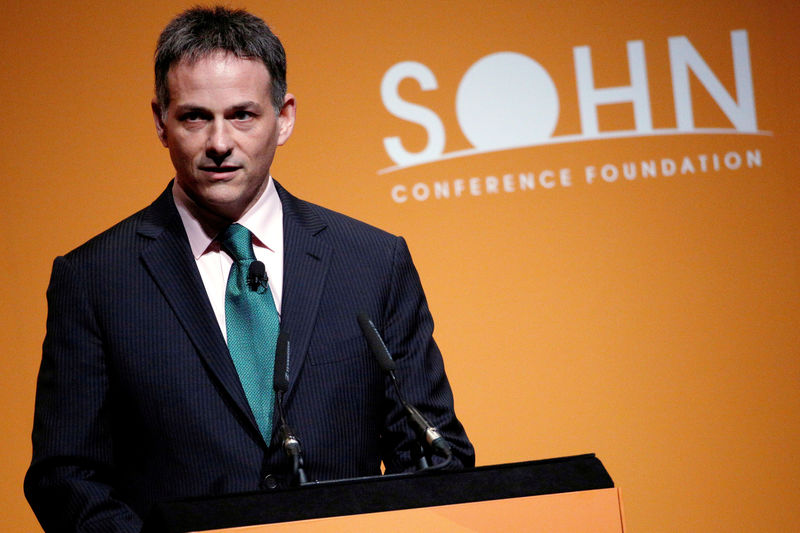By Michael Flaherty and David Randall
NEW YORK (Reuters) - Hedge fund manager David Einhorn's unusual plan to divide General Motors Co's (N:GM) shares into two classes poses a potential corporate governance minefield for GM board members.
The shareholder proposal, quickly rejected by the company this week, is aimed at boosting a lagging stock price, but did not appear to catch fire with other existing or prospective shareholders, who see it as an odd mix of hybrid security schemes.
The plan would create one class of stock for investors keen to capture GM's juicy dividend, and a second for those eager to bet on its growth potential.
Einhorn, who runs New York-based Greenlight Capital, has pledged to fight for it at the company's annual meeting and plans to nominate a slate of directors ready to advance his idea.
One obstacle cited by legal and financial advisers is the probable conflict it presents for GM's directors, who under Delaware law are required to be loyal to all shareholders. That could get tricky under Einhorn's plan as directors would oversee two classes of stock that each have voting powers but competing ambitions for use of company capital.
For instance, directors would have to square voting to raise quarterly payouts, which would exclusively benefit the dividend stock holders, versus allocating more toward capital expenditures or stock repurchases, which would benefit the growth stock camp.
"It puts the board in an odd position," said Charles Elson, a University of Delaware corporate governance professor who also sits on the board of restaurant chain Bob Evans Farms Inc (O:BOBE). "Do you plow money back into the business, or buy back the stock? You end up penalizing at least one of the stock holders. It gets messy."
Dividend holders would get one-tenth of a vote under the Einhorn plan, while the so called "capital appreciation" owners would have a full share.
While all public company boards encounter tension when evaluating short- and long-term goals, "separating out dividend-paying shares makes those tensions explicit, pitting actually different stockholders against each other," Delaware Law School professor Larry Hamermesh said.
Hamermesh added that such a structure could become more troublesome in terms of conflicts if the board's stock holdings were concentrated more in one class of stock.
DIVIDENDS VS. GROWTH
Investors - even some GM holders frustrated by its persistent underperformance since its shares returned to public markets in 2010 after a wrenching reorganization in bankruptcy - were not immediately lining up in support of Einhorn's idea.
"I agree completely that the stock is undervalued, but I'm not sure that splitting it into two classes is going to drive it any higher," said Scott Moore, co-portfolio manager of the Buffalo Dividend Focus fund, who owns shares of GM.
Moore said he doesn't want to have to choose between dividend income and stock price appreciation. He wants both.
So far, GM shares have not seen a big response to the Einhorn proposal. The stock gained about 2.5 percent on Tuesday after it was made public but ended little changed on Wednesday.
Mark Freeman, chief investment officer of Westwood Holdings Group, who does not own GM, said he would not buy a dividend-focused share class that was not a preferred stock. Preferreds stand between common shares and debt in a company capital structure and offer a greater likelihood that investors will have a claim on assets in the event of a bankruptcy.
Einhorn's plan has flavors of several existing hybrid equity security types, such as tracking stocks, perpetual preferred shares and master limited partnerships, but does not exactly replicate any of them.
To some degree, it harkens back to independent share trusts called "primes" and "scores," equity derivative securities that were popular in the late 1980s and early 1990s.
As under the Einhorn plan, investors interested in the stability provided by dividends could own a company's prime trusts, while those willing to take on more risk and bet on its growth could buy the scores.
The key difference, however, was that the trusts were established by shareholders, not the companies issuing the underlying stock. Companies themselves had no involvement at all, and their shares were not formally divided into two classes as Einhorn's proposal provides.
The trusts phased out in the early 90s following a disadvantageous change in tax rules.
GM itself has had multiple share structures in the past.
In the mid-1980s, the automaker made two splashy diversification moves, acquiring Electronic Data Systems Corp, a pioneering computer services company founded by future presidential candidate H. Ross Perot, and later Hughes Aircraft, the defense and satellite company founded by billionaire Howard Hughes.
GM then set up tracking stocks for each of the units. GM Class E shares, for EDS, and GM Class H shares, for Hughes, gave holders a dividend based on the profits of each operation, but no ownership stake.
GM’s own history suggests there are ways around the potential conflict posed by dual share classes.
In a 2005 case in Delaware Chancery Court, the company acknowledged that the board had an internal policy toward handling different shareholders when GM had a tracking stock.

According to a copy of the case obtained by Reuters, “Recognizing that the interests of ... shareholders may not always coincide, GM created a board committee called the Capital Stock Committee to determine the terms of any material transaction between GM and Hughes and ensure fairness to all shareholders.”